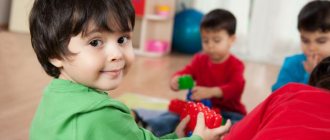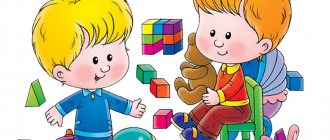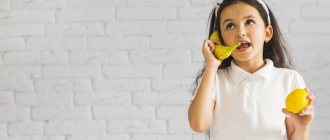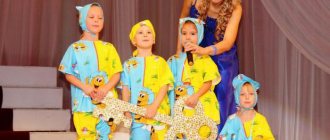Children in preschool age play and communicate a lot. It is during the period of increased interest of the child in communication that it is important not to miss the moment of development of competent, coherent speech. When talking with a child, pay attention not only to the correct use of words, but also to the logical sequence of his story. The development of speech and figurative thinking in preschool age turns out to be more important than teaching a child to read. Moreover, the educational system “Primary School of the 21st Century” does not require reading skills when entering first grade. But any school welcomes children with developed memory, logical and imaginative thinking and developed speech. Story pictures, a little time and parental patience will help develop all this.
Subject pictures - small stories
Story pictures can be one picture or a series of pictures united by meaning. For older preschoolers, pictures are suitable that show not only some action of the character in the illustration, but also contain many details. It’s not easy to compose a story based on one picture even for a junior schoolchild, and not all children can be interested in this activity. Another thing is a series of plot pictures. There can be from three to five to seven. There are picture books where the story is presented only with pictures in a certain sequence. They perfectly develop coherent speech and attention of the child.
But still, a series of individual pictures is more functional. When used in developmental classes, the child will learn to compose a coherent story through the use of logical thinking.
Find out your child's level of preparation for school
home
Municipal budgetary preschool educational institution No. 107, Lipetsk
| Address: Lipetsk, st. 8 March, 20/3 st. Tolstogo, 46a Phones: 77 54 98, 25 08 18, 25 01 22 Head: Soboleva Irina Vadimovna |
Municipal budgetary preschool educational institution No. 107 in Lipetsk has been operating since 1978.
Based on the order of the Department of Education of the Lipetsk city administration dated October 24, 2017 No. 1491, preschool educational institution No. 107 in Lipetsk was reorganized by merging with it preschool educational institution No. 48 in Lipetsk.
Head: Soboleva Irina Vadimovna.
State registration number of the entry on the creation of a legal entity: 1024840826152, registration certificate series 48 No. 001429397 issued by the Inspectorate of the Federal Tax Service of Russia for the Sovetsky District of Lipetsk on November 09, 1999.
Educational activities are carried out in accordance with the license for the right to conduct educational activities: series RO registration No. 1719 dated 02/13/2018
Legal address: Lipetsk city, st. 8 March, 20/3
st. Tolstogo, 46a
Passenger transport routes: 2,12, 302, 27, 30, 330, 352, 328, 315
Opening hours: from 7.00 to 19.00 daily, except weekends and holidays.
Phone numbers for inquiries: 77 54 98, 25 08 18, 25 01 22.
Email address:,
Website address:
Structure of the educational institution:
In the 2021-2022 academic year, 17 preschool groups operate in the preschool educational institution, including:
- first junior group (from 2 to 3 years old) - 2;
- second younger group (from 3 to 4 years old) - 1;
- middle group (from 4 to 5 years) - 2;
- senior group (from 5 to 6 years old) - 2;
- preparatory group (from 6 to 7 years old) - 2;
- speech therapy group (from 5 to 7 years) - 3;
- group of children with visual impairments - 2;
- group for children with mental retardation – 2;
- group for children with mental retardation (Down syndrome) - 1.
The educational activities of the institution are carried out in accordance with the Basic General Educational Program of Preschool Education of Preschool Educational Institution No. 107.
The preschool educational institution interacts with MBOU gymnasium No. 1 on issues of continuity of education.
The preschool institution is located in a single educational space with the Lipetsk State Pedagogical University named after P.P. Semenov-Tyan-Shansky, Regional Children's Library, Special Library for the Blind.
The preschool educational institution has access to the INTERNET network, provider "Center Telecom"
Founder: Department of Education of the Lipetsk City Administration
Founder's address: 398032, Lipetsk, Kosmonavtov Street, 56 a. Founder's email Website address: https://www.doal.ru/ Tel. 309-601 Fax: (4742)34-99-09
Chairman Bedrova Svetlana Valerievna
Reception days: the first and third Tuesday of the month from 14-00 to 17-30 in the Department of Education of the Lipetsk City Administration The Department of Education of the Lipetsk City Administration is a structural unit of the Lipetsk City Administration with the rights of a legal entity.
It will be interesting for everyone!
What's the best way to work with story pictures? To do this you need:
- lay out the pictures in front of the child;
- look at each picture and talk with your child about what they have in common;
- ask the child to arrange the pictures in the correct sequence;
- ask questions about the plot so that the child gives a complete answer to them.
Next, the child composes a short story on his own.
For a better understanding, let's look at an example. Let's turn to the series of pictures that make up the fairy tales of the wonderful children's writer and illustrator Vladimir Suteev: a series of pictures about children who were picking mushrooms in the forest and were scared when they saw sparkling eyes in a hole under a tree. They imagined that there was a terrible beast there, and, throwing the basket, ran away. A hunter was walking towards them. The guys told him about the terrible beast and, together with the hunter, went to that very tree. The hunter raised his gun and approached the hole in which the animal was sitting. But a small black kitten came out of the hole. The guys were very surprised.
- First, look at the picture and find the characters in the story. Do this with each picture - it is important that the child makes sure that a number of pictures are united in meaning.
- Then for each picture: who is shown in it? Why did the guys come to the forest? What did the guys see? How did you react? What did they do after that? Who was behind the bush? How did the guys behave then?
- Try to get your baby to answer as completely as possible, not limiting himself to one word.
- Now ask the child, looking at the pictures, to tell you in order everything that he saw and remembered. Thus, the baby got a story.
To make it more interesting for your preschooler, include a game moment: tell your version of the story and ask your child to evaluate your story.
About benefits and effectiveness
A series of plot pictures, as mentioned earlier, gives a universal effect, developing coherent, literate speech, imaginative and logical thinking.
- Logical thinking.
By looking at a series of pictures, a preschooler learns to identify a generalizing link in them and, on this basis, to conclude that the pictures are united by a storyline. In this way, analytical thinking is formed, as well as logical construction, with the help of which children compose a coherent story.
- Creative thinking.
Without imagination, it is basically impossible to compose a story from a picture. Let's say a series of pictures is dedicated to a hedgehog who found a balloon. The child will wonder: where did this same ball come from in the forest? This is where fantasy and imagination come to the rescue: friends were walking through the forest for a birthday party and missed one of the balloons.
- Coherent, literate speech.
It is formed from the age of 4–6 years, when a child can answer a question with a full, expanded sentence with homogeneous members. For its successful formation and training, a series of plot paintings will be very useful. The practice of composing stories, when there are clues in the form of pictures before your eyes, will help your child answer questions competently and coherently, paying attention to the details of what is happening.
How to work with your child on speech development: useful tips from my experience of games and activities using a book.
Games and exercises for children's speech development with story-based pictures.
In the article and in the book you will find six series of plot pictures
. Read the text of the assignments in advance and prepare the necessary material.
To complete some tasks, you will need to cut out rectangles from cardboard to the size of the pictures to cover the images. This is done so that the child tries to guess what will happen next or, conversely, to identify the cause of events. This way your baby will learn to establish cause-and-effect relationships, reason, draw conclusions, and prove his point of view. It is very important that the child himself tries to find answers to questions and makes assumptions. Don't be too quick to give the "correct" answer. The baby needs to make a small discovery himself and experience the joy of it.
mistakes
in answering questions , for example, says “prettier” or “brighter,” then do not scold him, do not laugh at the mistake, but tactfully correct him: “Think about how to say it correctly... Yes, you guessed it. We must say “brighter”.
Writing fairy tales from pictures
will help children learn to tell stories in a certain sequence, in accordance with the structure of the story (beginning, middle, end), use figurative expressive means of language, and will contribute to the development of the child’s imagination and creativity.
If it is difficult for a child to compose a fairy tale on his own, then help him. Say the beginning of phrases, and the baby will continue them himself. Look how this was done in the tasks for the pictures “Teddy Bear.” You can help your child by giving him a plan. If there is a long pause during the story, help the child with questions: “What happened to the pig next?” or “Where did the puppy go? Who did he meet?
Game “Guess which word is lost”
? Intended for children five years and older. This fun exercise in an entertaining way will teach your baby to hear and isolate the sounds of his native language from the flow of speech, that is, it will contribute to the development of phonemic hearing. If it is difficult for a child to find the right word, then highlight the wrong word in a couplet and offer to replace it. When selecting rhymes, encourage the child’s independence, do not rush to say the correct answer. Help him with a hint, for example, “Flour-...What is this? (point to the child’s hand).” “Hand!”, the baby will guess. Rejoice at his discovery and repeat these couple of words with him. If a sound in a task needs to be highlighted with a voice, then it is indicated in the text by several letters (“essskimo”, “gradussnik”).
When discussing proverbs with children
It is very important to help the child understand their meaning using specific examples from his life experience, fairy tales, and stories. Think about similar situations your child has been in or observed and talk about them.
not look at several series of pictures at one time with your child.
This leads to overtired children, reducing their interest in classes and their effectiveness. It is enough to talk about one episode and do additional tasks for it, given below. To complete additional tasks you will need toys, pencils or paints, and drawing paper. Prepare them in advance.
After looking at all the series of pictures
ask your child why they say this: “Health is more valuable than gold,” “Take care of your health from a young age.” Invite him to tell you how he takes care of his health, and write a letter to Aibolit about it. The child will dictate, and you will write down his story. Prompt your child to start phrases, and he will continue them. Ask your child to draw pictures for his story for Aibolit.
Additionally, you can conduct games and exercises with your child with subject pictures on the topic “Health”.
Name with your child or find in the pictures:
a) items necessary for the doctor and nurse to work;
b) objects that help us always be clean and tidy;
c) healthy foods.
Ask your child which of these items he has at home and why they are needed. Play the game "Guess the object"
».
Option 1. You describe the object, and the child guesses it. For example: “The doctor needs this item. It is glass, long, it helps to find out whether a person is sick, what his temperature is.” After several riddles, invite your child to tell you a similar riddle himself.
Option 2. The child makes a wish for one object. You try to guess what it is by asking questions. For example: “Is this item a product?” (No). “Does a doctor need this item to treat people?” (Yes). “Is he needed to give injections?” (Yes). "It's a syringe." (Yes). After a while, invite the child to switch roles.
Invite your child to pack his doctor's case. To do this, you need to draw all the objects that he will need for work and explain why he needs them.
I wish you the joy of communicating with your baby and interesting activities and games with him!
You will find a link to download pictures at the end of the article.
A series of pictures for storytelling 1. Teddy bear with a sweet tooth.
Who is in the picture? Call the little bear affectionately ( bear, little bear, little bear, little bear
).
What is the bear doing? What is he like? ( Clubfooted, happy, funny, amusing, cheerful, furry, joyful
).
Look at the second picture. What happened to the bear? How did you guess? Why does the bear have a toothache? Look at the third picture. Who did the bear come to? What does Aibolit do? Why do you need to brush your teeth every day?
Let's tell a fairy tale about this bear cub together: “Once upon a time... He loved to eat very much... One day Mishutka... There was a lot of honey... Teddy Bear... The next day he had... Mishka wandered to... Aibolit taught him... Now Mishutka...”. What can we call our fairy tale? It should be clear from the title what it says.
Honey is sweet. What else could be sweet? Guess my riddle: “Sweet, beautiful – is this a cake or candy?”, “Sweet, fragrant, tasty – is this honey or jam?”, Sweet, chocolate – is this candy or cake? What do you call a person who eats a lot of sweets? ( Gourmand, sweet tooth
).
Which word got lost?
The bear ate a lot of honey. The bear's oak tree is sick. ( Oak-tooth
). Say these lines correctly.
Now let's play rhymes. Replace the first sound in words with the sound z and you will guess the rhyme. For example, oak is a tooth. Try. It's fun and interesting. Mike - ... ( bunny)
, door - ... (
beast
), gave - ... (
hall
), carriage - ... (
pen
), set - ... (
fence
).
Complete the sentences. “We need teeth so that... If there is a lot of sweets, then... Mishutka’s teeth hurt because... I brush my teeth every day so that...”.
Additional task. What should you do to keep your teeth healthy and pain-free? ( Don’t eat a lot of sweets, brush your teeth with toothpaste every day, have your teeth treated by a doctor on time, eat healthy foods: fruits, vegetables, cottage cheese...).
Come up with signs that will help you remember Dr. Aibolit’s advice and draw them. Draw a no sign (for example, crossed out sugar and candy) and an allow sign (for example, a toothbrush and a clock or calendar).
A series of pictures for storytelling 2. How Piggy the pig learned to be neat.
Close the first picture and start looking at the second illustration . How is the piglet feeling? How did you know this? The piglet is crying. How can you say it differently? He...( cries, sheds tears, roars
).
What do you think happened to him? Why is he crying? Let's see if we guessed right or not (open the first picture). What is Piggy doing? What pig? ( Unwashed, sloppy, dirty, unkempt
). Where is he sitting? Have you already guessed why he got sick?
Look at the next picture (third). Who did Piggy come to? What does Aibolit do? Why did he take soap, a brush and a basin of water? Why does he need a towel? Now you will be Aibolit. Tell Piggy what needs to be done so that such troubles don’t happen to him again.
Come up with a fairy tale about how Aibolit taught Khryusha to be neat.
Guess which word is lost.
The pig was dirty. The doctor dug it with soap. ( Soap-snout
). Say these lines correctly.
It's time for a rhyming game. Replace the first sound in words with the sound r and you will guess the rhyme. Soap - ...( dug
), varnish - ... (
crayfish
), mother - ... (
frame
), salt - ... (
role
), cat - ... (
mouth
), flour - ... (
hand
), trunk - ... (robot).
Additional task: Why can’t you eat with dirty hands? Is it possible to eat and at the same time play with sand, with boats in a puddle, with pets? Why? When should you wash your hands? ( After using the toilet, walking, before eating
...). Why do we wash our hands with soap?
What else do you need to do to be clean and tidy? Why do they say: “Sun, air and water are our best friends”? How does water help us be healthy? ( We wash our hands, wash ourselves, bathe, swim, wash clothes, wipe off the dust with a damp cloth, harden ourselves
…).
What would happen if the water disappeared? How do you keep things clean? Draw a picture about helping water. How do fresh air and sun help us be healthy? Why is it useful to walk in the forest or park? Why do you need to ventilate the room?
A series of pictures for storytelling 3. How the puppy learned to get acquainted.
Look at the first picture. What happened on the lawn? What is the chicken's mood? How did you guess? The puppy wanted to meet the chicken, and the chicken got angry with him. How do you think why? What did the puppy do wrong?
Look at the second picture. What happened to the puppy? Why did his nose hurt? Why does the doctor lubricate the wound with iodine? Say in one exhale: “Oh-oh-oh, oh-oh-oh, my nose hurts!” (development of speech breathing). What does a puppy need to remember so that this doesn’t happen to him next time?
Does the chick look like its mother? How are they similar? What is the difference? I'll start, and you finish. The hen has a large beak, and the chicken has a small...( beak
).
The mother has big wings, but the chick has small ones...( wings
).
The hen has long feathers, and the chick has short...( feathers
).
The chicken has a big head, and the chicken has a small...( head)
.
The chicken has a big tail, and the chicken has...( tail
).
Make up a story about how a puppy wanted to meet a chicken and what came of it. What will you call her? It should be clear from the title what your story is about.
Find which word is lost:
Rook anointed his nose with iodine so that the dog could run healthy. ( Rook Doctor
).
Repeat these lines correctly.
Additional task: Do you know how to meet people? What words are you saying? ( Hello. Let's get to know each other. My name is... What's your name? How old are you? What do you like to do? Let's play together
...). Play out an acquaintance scene with toys
A series of pictures for storytelling 4. Bouncing bunny.
Close the second picture. Look at the first illustration. Who is in the picture? Call the little bunny affectionately. ( Bunny, bunny, bunny, bunny, bunny
).
What bunny? ( Cheerful, fluffy, nimble, dexterous, agile
).
The bunny has long ears. How can you say about him? He...( long-eared
).
He has a short tail. Bunny...( short-tailed
).
The hare has big eyes. He...( big-eyed
).
Look at the third picture (the second is still closed). What happened to the bunny? How did you figure this out? Why does Aibolit bandage his paw? Think about what happened to the bunny, how he injured his paw.
Let's see if you guessed right (open the second picture). What happened to the bunny? Why did this happen to him?
Let's come up with a riddle about a bunny. "He's gray like...( mouse
).
He is fluffy like...( cotton wool
).
He is as nimble as... ( a sparrow
). Who is this?". Tell this riddle to your friends.
What do the proverbs “Look before you leap”, “Look at your feet: you won’t find anything, at least you won’t hurt your legs” teach us?
Which word got lost?
The bunny jumped merrily. It's a pity that I broke my hat. (Hat-paw). Say it right.
Let's play rhymes. Replace the first sound in words with the sound l, and you will find a rhyme. Cat -…( spoon
), beetle -...(
bow
), lady -...(
llama
), poppy -...(
crayfish
), helmet -...(
mask
). What sound was hidden from you in the words lllapa, skakallka, sllomall, jumpalll, zabinowall? Think of other words with the sound l.
Additional task: The bunny loves to jump. What outdoor games and exercises do you like? Are they good for health? Do you know why you need to do exercises in the morning? (It drives away sleep, gives cheerfulness, joy, improves health, teaches you to move correctly and beautifully
).
What sports games do you know? What is an athlete who plays football called? ( Football player
).
Hockey? (Hockey player
).
Volleyball? ( Volleyball player
).
Basketball? (Basketball player
).
Tennis? ( Tennis player
).
Swimming? ( Swimmer
).
Skis? ( Skier).
Jumping?
( Jumper
).
A series of pictures for storytelling 5. About sweet ice cream and bitter medicine.
Look at the first picture with your child (the second and third should be closed). What is the squirrel doing? How many servings of ice cream has she already eaten? How do you know? What is the squirrel's mood? ( Cheerful, joyful, cheerful
). Why is she so happy? What could happen to the squirrel next? Why do you think so?
Make up a story about what happened to the squirrel.
Now let's open the second picture. How is the squirrel feeling? What's her mood? Why did she tie the scarf around her throat? Why is she holding a thermometer? What do you think Aibolit will need to cure her? What advice will he give her?
Let's open the third picture. What does Aibolit do? The squirrel drank a spoonful of the mixture and wrinkled its face. What was the mixture? What else could be bitter? When the squirrel ate ice cream, it smiled. What kind of ice cream was it? What's healthier - ice cream or an apple? Candy or carrot? Juice or Fanta? Why?
Which word got lost?
The baby squirrel got sick. She drinks cat medicine. (Spoon cat). Repeat these lines correctly.
Guess what sound occurs in all the words I speak. I ate it, essskimo, thermometer. (Sound c). Clap your hands if you hear the s sound in the word. Mixture, tablet, medicine, glass, scarf, spoon, tail, throat, bag.
Additional tasks. Talk to your child about healthy foods. Offer to play grocery store. Let your child draw a window display for this store. Ask your child why he drew these particular products and why they are useful. Ask which ones he will buy in the store. Together with your child, think about what dishes can be prepared from his products. Create your own book of favorite and healthy dishes. The kid will draw pictures in it, and you will write captions for them.
Tips for parents
We all know that in the early stages of development, a child learns what interests him. In order for the process of learning storytelling from story pictures to be both useful and interesting, you should adhere to some rules:
- Make sure that the sentences in your child’s story are clear and complete.
- Ask more questions, show your interest.
- Try to be active and respond quickly to your child’s answers.
- Write down the resulting sentences, so the baby’s story will become clear.
- You should not correct your child if he talks about the topic of the pictures. But if the baby gets carried away and is just chatting in vain, it is necessary to direct him to the subject of the story.
- If you have just started working with story pictures, then start with a short story.
- To immediately interest your child in such activities, try starting with funny pictures. Children love humor as much as adults and will be happy to tell you a funny story.
And of course, parents of young storytellers need to remember patience and tact. Over time, the baby will learn everything, even if it may take him a little longer than his peers.
Sofia Rogozinskaya





